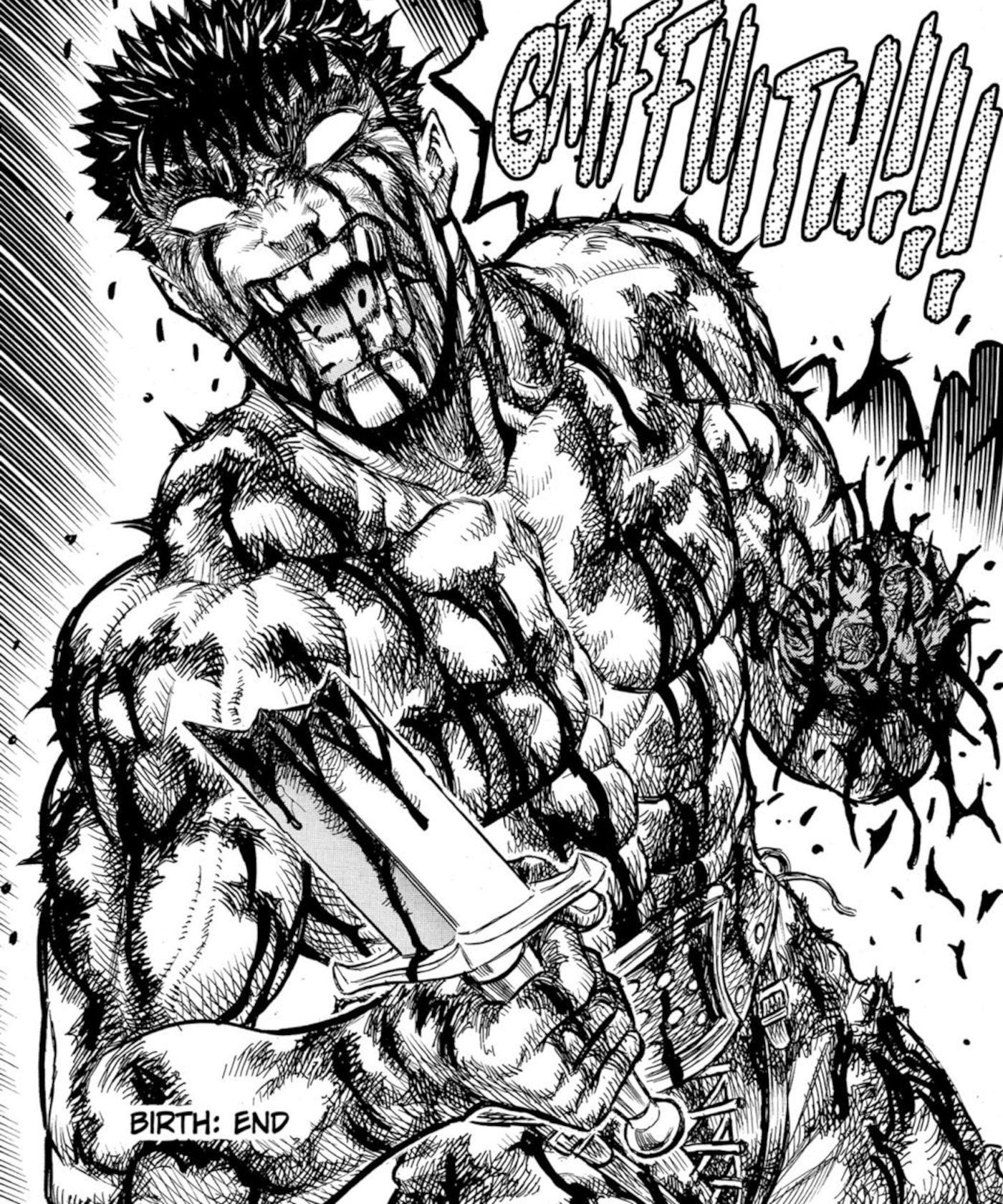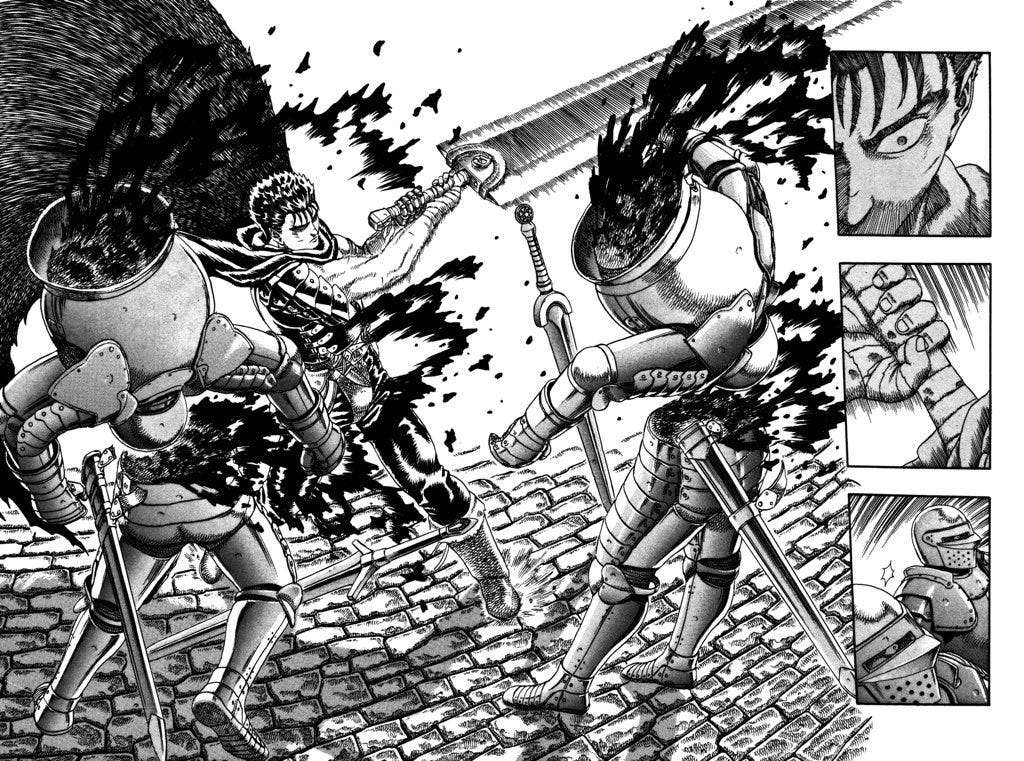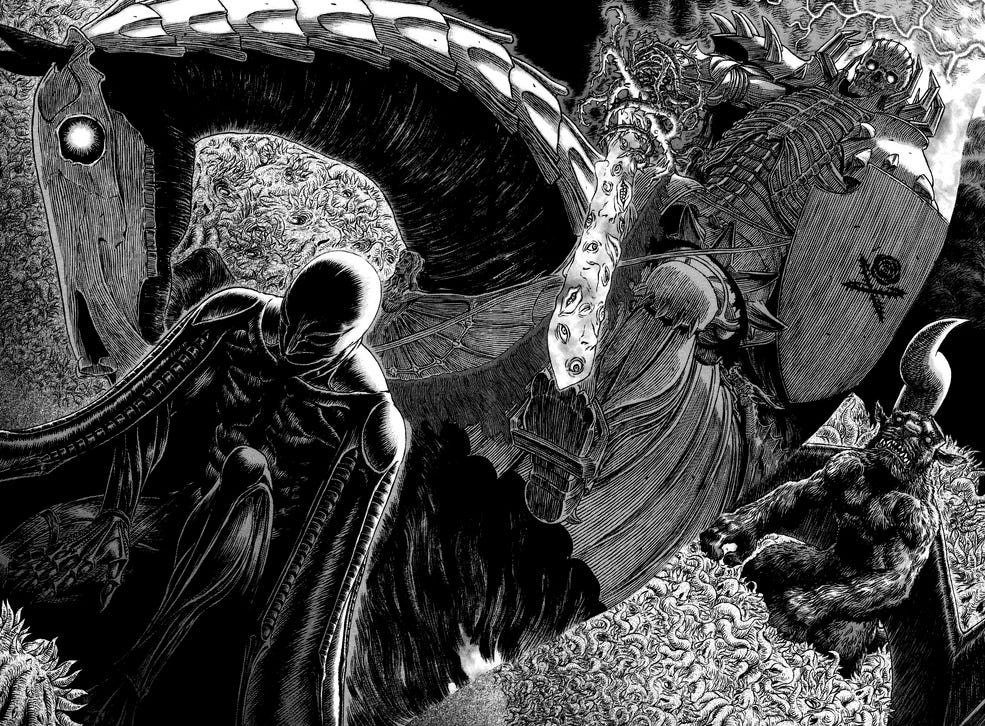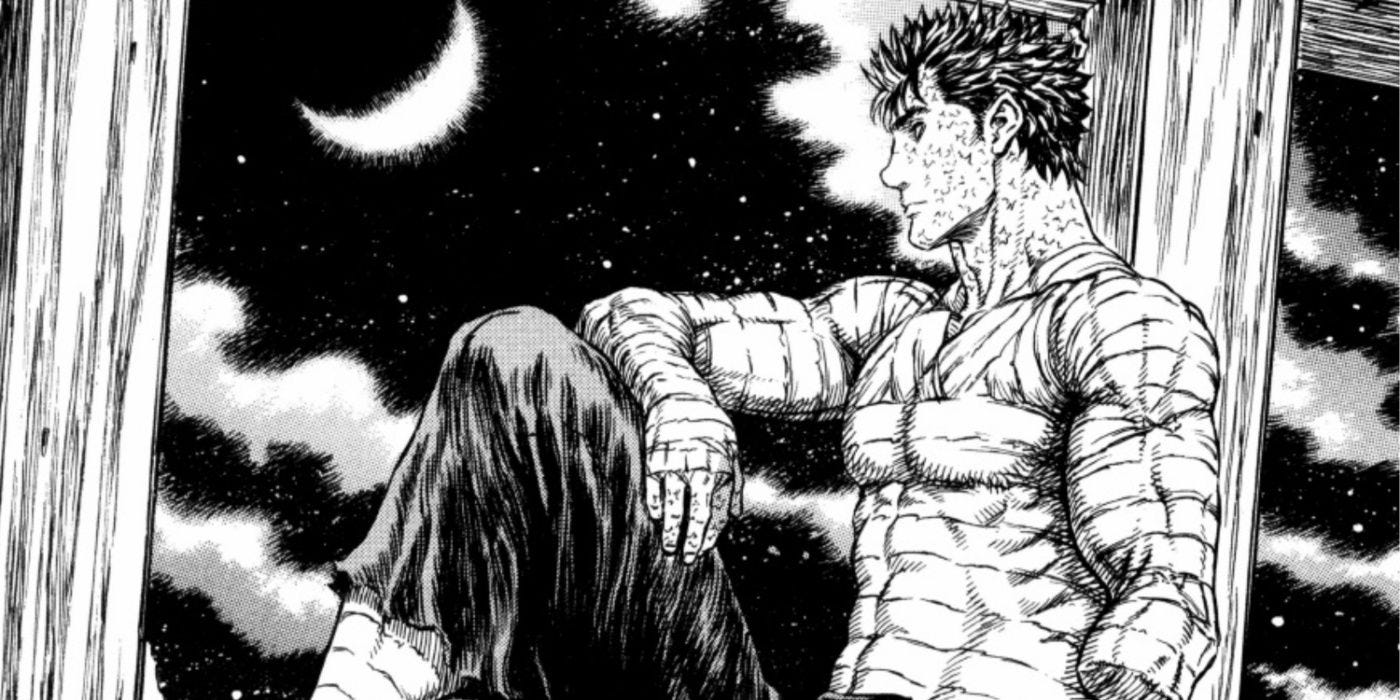When I was a young man and full of life, as opposed to what I am now, a middle-aged man who could use a topping off in the life department, manga was a big deal in terms of book challenges.
I mean, I can see why:
My personal favorite series, Berserk, OPENS with our “hero” railing some lady in the woods, who turns out to be a demon or monster or something, and then he dispatches her, violently. Not 10 pages in and we’ve got sex and violence, the two most ban-able things that can be in a book.
Let’s talk about manga for a minute. Because right now, I think the focus is on gender/sexuality-based non-fiction comics, and sometimes I think it can be easier to talk about a topic like this by examining a parallel.
The tone of manga can be quite different from American comics. I think it’s fair to say that sexuality and “lovingly rendered” human forms are more common. Even in the mostly-kid-friendly Dragonball, there’s a running gag in the series where Goku, our protagonist, who is sort of like a feral, but nice, child raised with no understanding of humanity, goes around patting people on their crotches as a way to determine whether they are male or female, a concept he’s just learned (this manga started its original run in 1984, so if the “genitals = gender” thing is bothersome to you, I guess I would say that Goku’s gross oversimplification of genders is part of why this is funny, but also, you can just skip it, you’ll be fine).
Any way you slice it
comics, whether homegrown or imported, have long been the subject of book challenges, and usually on a level not experienced by most other books, even other books that, like comics, are not often in curricula and that are not on the same level of phenomena as Harry Potter (there is no Berserk theme park. Which is probably for the best. I think it’d be a tour of human suffering).
Why is this?
Reason 1: Our Feelings About Visual Stimuli
Visual depictions of sex and violence will always have a harder time passing through the gates of censorship than written versions of the same thing.
There is some filthy romance on your library shelves. I guarantee it on the level of that guy from Men’s Wearhouse guaranteeing you’ll like the way you look. I know he probably wears the suits from Men’s Wearhouse, but I gotta believe that when they’re tailoring something for the big boss, they take a little more care than they do for me, the guy buying some crazy-ass suit off the 40% off rack once every couple decades.
Embedded in those text-only book pages, in a boring font, in a non-descript, paperback book, there is some absolutely smutty sex going on.
And this is roundly accepted.
Whereas having a Playboy subscription at the library would not be, even though we’re talking about soft focus nude pictorials as opposed to vivid descriptions of penetration. Does Playboy still have nudes in it? I know for a hot minute they were not having nudes, then went back to having them, maybe? Surely other magazines haven’t attempted this same thing. You don’t call your magazine “Jugs” and then attempt to fill it with George Saunders short stories, right?
Movies, photos, and even drawings of human sexuality and violence are received differently from writing about those same things, and it’s got nothing to do with the level of violence/sexuality, it’s about visuals that are created for you versus visuals you have to create in your mind.
Someone watching porn on their smartphone on the subway, politely using headphones if they have the sound on, is thought of VERY differently from someone who is reading equally erotic text using the same device.
It’s not really something I can explain, and I don’t think it’s within my power to change everyone’s mind about it, but I can make a couple guesses as to how we got here:
One is that images are more direct, more visceral, and more easily “enjoyed,” so we see them as crude, simple, and appealing to the basic, animal side of us more than, say, a piece of text that you’d have to be literate to understand.
Two is that this whole text-based erotica thing was probably quite appealing to folks back in the day when it would not be acceptable to have a pornographic item in your home, let alone holding one on the subway. It was a method of titillation delivery that was lowkey: just throw a book in the ol’ nightstand, and even if your spouse saw you reading it, they probably wouldn’t think anything of it. It’s a Longarm book. That’s a western, right? Right…?
Well, yes, but also, the “Comstock Lode” in Longarm may have a different meaning. If you catch my drift.
If you didn’t catch my drift, it’s sex. Sex all over the place in those things.
The important thing I want to impart here is that it’s not about the level of titillation or filthiness, it’s about the method of delivery. A brief glance of a topless woman in a comic is going to cause you a lot more problems than a chapters-long drug-fueled orgy in a text-only form, even though one of these is a lot more sexually focused than the other.
Reason 2: Accessibility
Even if I KNOW that 50 Shades contains explicit sex, I’d have to skim through the book to find it (and probably skim more of it than I care to, which kind of has me thinking, “You know what? This doesn’t have as much sex popping off the page as I thought.”).
A 50 Shades DVD with sex scenes, I’d have to take it home to skim through. I can’t just see still frames when I’m holding the item in the library.
Ah, but a comic, I can flip through that with incredible speed and locate the sexy, violent bits without so much as a dig in my wallet for the ol’ library card. If I glance over at a kid reading a comic, there’s a chance I might instantly see something I do not like.
It’s very easy to look through a comic, locate, and isolate a panel with material that, even to someone who is not easily offended, might seem like a bit much.
Reason 3: Context
It’s very easy to view comic book pages, even individual panels, in a context-less way.
A printed text serves as its own reminder that the salacious scene you’re reading represents only a very small portion of something. There will be characters you don’t know and can’t describe, you won’t know the setting, you won’t know why any of what is happening is happening. Without those quick, simple visual cues, it is undeniable that there is an entire world of other stuff outside this one scene, and one can’t help but wonder whether the scene has a different meaning, a different tone, in context.
For some folks, the characters being married and engaging in a sex act for the purpose of conception is REALLY different from the same act committed by the same two characters for the purpose of, well, doing it. And in a text, that context may be asked for where in a comic, it seems less relevant.
Reason 4: The Perception of Child-Friendly Comics
There is a perception that comics are entertainment for children, and I do gather that this is a more pronounced difference between manga and western comics.
In Japan, there are different types of comics for different people. There are more adult, violent, sexual manga, there are more kid friendly books, there are types that lean towards the romcom crowd.
There also seems to be a bit less stigma around sexuality in comics, but that could just be my POV.
That division of book types exists in America, too, but it’s not as much of a built-in, widely accepted part of comics.
Back in the day, when I’d make a trip to Mile High Comics, there was an adult section, and it felt like stepping into a seedy porno theater in Times Square in the 70s. This was very clearly delineated, and everything about it made it clear that you should be at least a little ashamed to be standing there.
I think a lot of this has to do with the perception in America that superhero comics are, basically, the only type of comics. Superheroes are generally keyed towards younger audiences, or at least, they are designed to be appropriate for younger audiences, even when their storylines are more mature. There’s less a feeling in comics that exists in other media, that there’s something for every age group.
You would fully expect to go to Blockbuster and see Rated R movies. There were always movies with SOME nudity, sex, and violence in them, oftentimes intermingled all in one convenient VHS from Full Moon Entertainment.
Whereas comics that depict those things are less expected.
Reason 5: Frivolity
Comics are typically viewed as just for funsies, very unserious, and as something that isn’t important to anyone, really.
Coming for a comic is a bit easier because it’s like coming for someone’s Halloween decoration of a skeleton peeing into a toxic waste barrel as opposed to coming for their nativity scene on Christmas: it’s a sillier pursuit perceived as having no core values behind it, therefore it’s harder to defend.
I could go on and on about how that’s bullshit. I could relate to you my personal tale, one of a kid who didn’t read a goddamn thing other than comics from age 10 to 18, who ended up getting an English degree and working in libraries. But we don’t need to defend comics on that level. Instead, let’s focus on the way comics are no more frivolous than anything else.
Is anyone really going to tell me that a comic book is more frivolous than a cozy mystery where an elderly woman solves mysteries with the help of her plucky cat? Is anyone really going to throw a stone from the glass house of saying that a James Patterson thriller is important literature in a way a comic book is not? Can any pot call the comics kettle black while they use the self-checkout machine to take home a book about a bunch of kids who are stuck on an island and have to kill each other for sport? Do you find that slope grippy, not the least bit slippery?
Bringing It Around
Berserk is a violent book with quite a bit of sexuality in it.
But I have to say that the sex and violence are not played for laughs. They are not light topics. They’re not even meant to be titillating.
Berserk is wild. I started reading it, unsure if I’d continue. I decided to keep going until I read a volume in which I didn’t find something unbelievably weird, disturbing, or stunning, visually.
Sometimes you’d get all three in one panel.
The further I got, the better the story got.
Berserk is, on its surface, a story about a swordsman with a ridiculously big sword, slashing his way through a bunch of demons.
And when you skim through it with the aim to find something offensive, that’s easily done.
But there is a lot more to Berserk than meets the skimming eye.
It becomes a story about community and found family (seriously), and about deciding whether what you wanted when you were young and angry is still what you want when you’re a little older and wiser.
It becomes a story about personal sacrifice and what might be worth losing your life over.
It becomes a story, or rather, it always WAS a story, about what makes life worth struggling through.
It’s a beautiful, singular vision, gorgeously illustrated. Like some of the best forms of media, it’s not always easy to sit through. It has moments that are really tough.
The tough moments make it worthwhile, though. When there is the occasional contemplative, thoughtful part, the blood and Guts make it feel earned.
Dismissing Berserk outright is something I almost did. Not out of offense, but because I didn’t give it the time to become what it really is. It’s like cutting a flower before it blooms and then moving on, saying, “That wasn’t all that great, I don’t get what the fuss is all about.”
If you poke around, you’ll find a hardcore, devoted set of Berserk fans who spend a lot of their time theorizing and philosophizing about Berserk, and probably just as much time searching, in vain, for a book that’s nearly as good.
Berserk is something I’m certain has been challenged in many a library, and something that is not easy to defend without reading it, and reading all of it. It’s an easy target on so many levels, even levels we don’t typically associate with book bans. I could see someone with progressive ideals making the “toxic masculinity” argument, even though I would argue that the book is sending pretty much the opposite message (it takes some time to get there, passing through a T.M. phase before emerging into something else).
Berserk will forever be the example of something that, in my personal and professional opinion, is worthy of space on your library’s shelves. It’s worth the struggle to make it available to your community.
I’m going to continue next week with a bit about comics in libraries, specifically about how you might manage the placement of the collection. Then we’ll do something about some advice I have for buying and cataloging your comics so that you can make it easy for readers to get what they want and what they need.
Which, when it comes to comics, are the same thing.
Then we’ll do a bit about defending comics from book challenges.
Then we’ll probably do something else. Who knows?
Does it shock you that this is not a well-thought-out newsletter? Seriously?







One of the awful parts of the book banning conversation is how many books (especially in YA) were cancelled before they even were published by well meaning activists (often competing YA authors). Maybe some of those books were awful but maybe some were as amazing as “Berserk” they remain unknown. Often pieces were used out of context to rile people up & often no one investigated further than the offending quote.
I generally take a hard line at censorship and you’re right-graphic novels are often unlamented casualties beset on by the left & right for various sins.
At any rate, great example!!! Thanks!